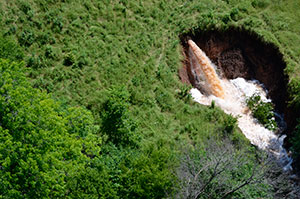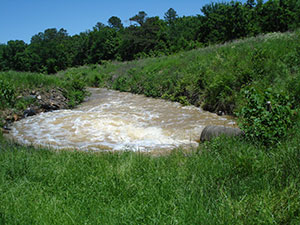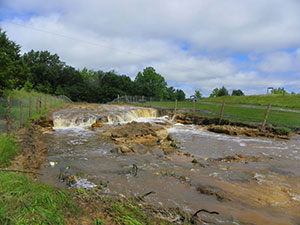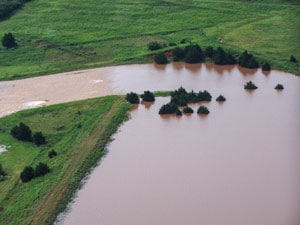Damage assessment of flood control infrastructure begins
OKLAHOMA CITY (June 2, 2015)—All of Oklahoma’s flood control infrastructure suffered wear and tear during a month of historic rainfall. As floodwaters recede, crews are inspecting the 2,107 dams operated by conservation districts for damage.

“It’s impossible to say the extent of damage caused to the dams until the water goes down—that is taking some time,” said Tammy Sawatzky, Oklahoma Conservation Commission Conservation Programs Division director. “Preliminary inspections indicate the cost of repairs may run in the millions of dollars.”

Heavy rain caused the grass covered auxiliary spillways of 133 dams to flow with water. This design feature prevents water from overtopping the earthen dams and threatening structural integrity. Of these 133 dams, 21 incurred damage; of which 4 suffered significant damage.
Damages observed include cuts into the base of dams from backward flowing water, dislodged spillway pipes and heavy erosion in auxiliary spillways.
“Minor repairs can cost between $1,000 and $5,000, while more serious repairs can cost up to $75,000,” said Sawatzky. “Multiply that by 2,107 dams, and the repair cost is potentially quite high.”


Some funding for repairs is expected to come from USDA Natural Resources Conservation Service (NRCS) Emergency Watershed Protection Program. The program allows conservation districts and similar entities to secure emergency repair funding on a cost-share basis. NRCS covers up to 75 percent of the repair costs and the remaining 25 percent must come from a local source. Local contributions may come in the form of in-kind contributions such as labor and equipment.
Oklahoma’s $2 billion flood control infrastructure costs $2 million annually to maintain. This maintenance cost comes in addition to emergency repairs such as those needed now. In exchange, the dams provide an average $88 million in flood damage prevention annually. For the period of April 18-May 31, the dams prevented an estimated $101.2 million in flood damage to property, businesses and other infrastructure according to NRCS Water Resource Office.
